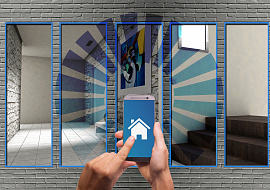How can Enterprise IoT solutions accelerate digital transformation?
It seems obvious that to stay competitive, businesses must become digital. Do you remember the last time you sent or received a fax at work? Thus, it is essential to keep a minimal digital standard. But the main question for businesses should be asked now very frankly: what benefits do digitalization bring directly to my company? How much can it grow through new technologies?
The next major question that naturally arises is: How can your organization actualize the digital transformation? Let’s say your company has already identified the benefits of digitalization. Not everyone can do it seamlessly though considering the highly-structured nature and operations in difficult-to-reach areas, as well as increased safety requirements and little room for risk. Especially with industries like construction, mining, and agriculture, these challenges are quite commonplace. Fortunately, the technologies behind it are continuously evolving to offer you a “winning combination” of digital solutions for a successful digital transformation. Our engineers at PSA first encountered the digital revolution back in the early era of M2M connections, when we had the honor of helping clients as they struggled with the first known pitfalls. Today, we continue to improve business efficiency and effectiveness through our ongoing development of comprehensive Enterprise IoT solutions. In this article, we’ll reveal how companies can successfully start, or continue their digitalization by discovering the main key – Enterprise IoT solutions.
Why do we need to be digital?
Digital transformation hasn’t stopped with desktop computers. The level of a company’s digitalization now is usually determined by the level of digitalization for its assets, usage, and labor. For product companies, it can also be crucial to improve their products through digitalization, for instance by customizing thermometers or expanding an agricultural product range with a digital irrigation system.
According to the latest statistics, almost 70% of companies have a digital transformation strategy or are working on it. These organizations define the following reasons as to why digitalization can be beneficial for them:

It’s easy to see that many of these factors are interdependent or result from the same digital improvements. For instance, by replacing the legacy button-operated interface with the sensor interface in a tabletop printer, one company was able to enhance its final product quality, which naturally had a rippling effect on operational efficiency, and in turn, led to a higher level of customer satisfaction. We bring your attention to this particular project to show that having one clear goal is critical for building a robust digital strategy. The more comprehensive approach you follow, the more value you can get. This is true regarding both production and enterprise process improvement, because digital enterprise processes can significantly improve performance, while IoT can accelerate the adoption. Read on as we reveal how it happens.
Enterprise IoT solutions and Digital Transformation: How do they match?
Take a look at these four core target components that typically describe the digital enterprise of today:
- Automation
- Efficiency
- Security
- Maintenance
Sound familiar? IoT adopters will have seen the benefits and key points within the IoT ecosystem development strategy. One question is why can’t we go digital by full-fledged IoT ecosystem development instead of gradually coordinating each component above with digital technologies? IoT adoption is generally accepted as one of a company’s digital indicators, but it is much more effective to consider IoT as a tool for the enterprise organization to be transformed. This approach allows us to overcome any inflated expectations, for example implementing IoT components and expecting the company's revenue to soar. It’s also important to ensure each tool is used strategically.
Essentially, an IoT implementation strategy is more complex than different digital strategies but after executing it, you’ll have a comprehensive insight into all the enterprise processes, their leakages, and interdependencies. That’s why we call it an ecosystem, where all the components, from sensors to people, interact with each other to achieve the main business goals.
In addition to their comprehensive nature, IoT ecosystems are flexible and allow companies to implement regardless of their own digital level. Therefore, we recommend considering Enterprise IoT solutions for these two main digital strategies:
-
Initial digitalization. By implementing an IoT ecosystem, business naturally becomes digitized. By connecting crucial assets, such as equipment, vehicles, or cargo to intelligence, you can always see their real-time status, monitor environmental conditions, people’s behavior, track location, and so on. By implementing analytical tools to the IoT ecosystem, you can also predict when equipment might fail, create optimal routes considering more factors, or identify failures due to human factors. You also definitely want to implement a cybersecurity program there due to the potential vulnerability of the endpoints. Within this concept, a new business strategy acts like a goal while Enterprise IoT solutions are the effective tools for reaching that goal.
- Advanced digitalization. Apart from the ability to show the vector for further business development, Enterprise IoT solutions are convenient to determine the further vector for the digital development of a company. For example, if at the first step you implemented machine vision for improving QA processes, you can now track its efficiency and pick up complementary solutions. When all the critical assets are equipped with IoT sensors, companies can move further to implement a digital twin and meticulously investigate data in their IoT ecosystems. Thus, you gain a strong analytical advantage allowing you to predict trends or simulate cases.
Need help implementing Enterprise IoT solutions?
Accelerating Digital Transformation with Enterprise IoT solutions: Use Cases
To realize how to accelerate transformation, we first need to realize what can slow this process down. Below we identified the main digital brakes we’ve been noticing, as well as solutions on how to overcome them.
Innovations can disrupt highly structured companies – Choose Enterprise IoT solutions rationally
Implementation of innovations definitely changes working models, as a rule, to be more productive. Especially for highly structured industries like rail, mining, or construction, irrational innovations can really disrupt operations. Therefore, they should consider Enterprise IoT solutions with structure in mind first. The lucky benefit is that IoT technologies are flexible and allow them to be implemented incrementally. Now, we have successful cases on how some industries who were traditionally unsuccessful in digital have now soared there in recent years.
For instance, in 2015 Healthcare was recognized as one of the least digitized industries. It is lost in most of the digital components, from the workforce to transactions. However, in 2018, healthcare was called one of the top digital business strategy adopters, along with the financial and services sectors. What can we see now? Improving telemedicine, wearables, smart pharmacy and smart hospitals are appearing around the country, meaning healthcare is successfully managing the Enterprise IoT adoption and does continue to evolve. An interesting story we’ve been observing with the gas and oil industry: While it was referred to as highly digitized in general, its assets, stock and interactions suffered from the lack of new technologies. By continuing to evolve, the oil industry can entirely realize its digital potential as we can see in the case describing tracking application development for an oil well.
Lack of safety in harsh working conditions – Research all the possible options
If an Enterprise IoT integration is technically challenging for your company, we recommend performing marketing research more often. Since the statistics are open, Enterprise IoT providers are evolving their technical tools to spread the potential implementation area too, and maybe next month it will appear aligned with working conditions in your enterprise. For mining operations, which are usually held in vast and difficult-to-reach areas and which suffer from lack of connectivity, the possible solution can be implementing meshnets to ensure a reliable IoT ecosystem. As a result – the entire area is fully monitored, and you definitely know that your mining machines won’t break in the coming months.
Or builders, who definitely can’t use sensor devices to take measurements, or even their smartphones to get notifications. Buildings themselves obviously can’t be equipped with sensors. Thus, when it comes to personnel safety, it is convenient to equip them with wearables to track their health, the environment around them, and send notifications. Installing an advanced IoT system to measure building parameters from a distance, and identify and analyze all the suspicious changes, thus saving time for a construction workforce. As a result, the asset stays fully under control.
People’s resistance – Increase the awareness
Despite a big number of resources devoted to how to adapt employees to Enterprise IoT infrastructure within a company, line workers are less resistant to innovations’ adoption. Top management is usually the most resistant since they have total responsibility for the business. Essentially, it is the only right decision to approach innovations pragmatically, estimating thoughtfully all pros and cons. Therefore, higher level leaders should get detailed and extremely precise reports on how particular Enterprise IoT solutions will influence the business processes and revenue of the company. While preparing an implementation strategy, it is critical to calculate all the situations, risks, and ROI, and share objective statistics. Thus, there are more chances that a technology vital for a particular enterprise will be approved.
Stuck in the middle – Improve AI solutions
The smarter a system becomes, the more responsible decisions it can take. The more responsible decisions the system takes, the faster digitalization runs within a company. It becomes real through the AI systems feature to be self-learning. It can also be a budget-saving solution, because of utilizing the potential of neural networks. Look at how AI has improved QA processes within a printing manufacturing operation. It came to produce fewer defective items with time: from 100 in the first month to 10 in 6 months. The system became smarter and more predictive without the need for a high-resolution camera.
Thus, there are numerous use cases to cover particular business goals that are known by experienced IoT ecosystem developers. The quickest way to explore them to find out what is suitable for your company is to get connected.
Wrapping up
-
It is much more efficient to consider the IoT ecosystem not as an end goal, but as an effective instrument for reaching business goals through digital transformation.
-
The main benefits for companies from digitalization are improving operational efficiency, meeting changing customer expectations, and improving new product quality. By implementing Enterprise IoT solutions, it becomes easier to get real time insights.
-
By deploying an IoT ecosystem, you will get a comprehensive insight into all the enterprise processes, their leakages, and interdependencies. It allows to build more informed business strategies in shorter terms than if moving to digital gradually.
-
Enterprise IoT solutions suit both initial and advanced digitalizations thanks to a large volume of data analyzed.
-
Since Enterprise IoT is not a cutting-edge idea, you can analyze various cases in detail to avoid most of the risks and create an invulnerable business strategy.
Want to move to digital with minimal risks? PSA has already started helping companies digitize their businesses at the dawn of the digital revolution, constantly evolving to adapt clients’ needs to current technological opportunities. At IoT consulting stage, we precisely identify all the bottlenecks that interfere in your company with digitizing, and offer a robust, custom Enterprise IoT implementation strategy. Let’s get connected!














